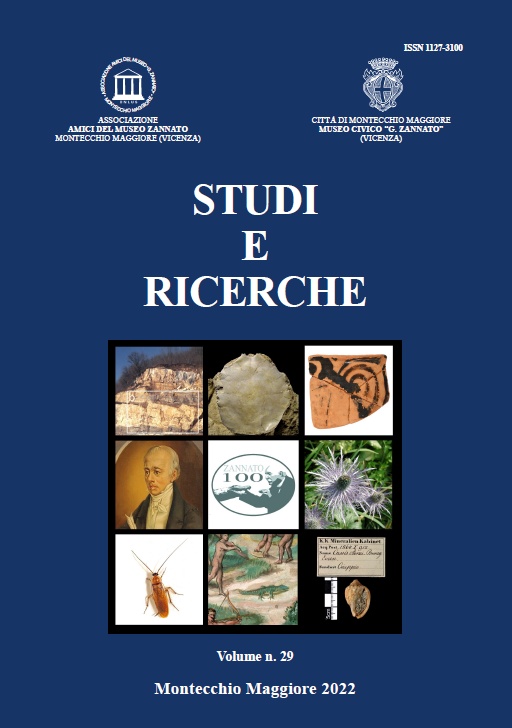Since 1994, the museum has published its own scientific journal, Studies and Research, as well as a number of monographs and articles of a naturalistic or archaeological nature.
The Editorial Board annually evaluates the publication of contributions of high scientific value. Unpublished works concerning topics within the field of natural sciences and archaeology are considered for publication, with preference given to those concerning the Veneto region and in particular the Vicenza area; a maximum of 2 articles per Author/Co-Author can be published.
The papers are first evaluated by the Editorial Board of the Journal, which submits them for peer review by external experts: articles that do not respect the relevance of the journal or are manifestly far from the quality standards of the Journal may be directly rejected by the Editorial Board. There is no cost to Authors for publication.
Download here the Authors’ Guidelines
COMPLETE VOLUMES:

Articles Database
You can search and browse all works produced by the museum here, using tags or search or by scrolling through the catalog by year of publication.
2011
Santo N D; Zorzi F
ASCE IN PIETRA LEVIGATA DAL TERRITORIO DI MONTECCHIO MAGGIORE E BRENDOLA (VICENZA): ASPETTI ARCHEOLOGICI E MINERALOGICI Journal Article
In: Studi e Ricerche, no. 18, pp. 53 - 61, 2011, ISSN: 1127-3100.
Abstract | Links | BibTeX | Tags: analysis, axes, greenstones, mineralogy, prehistory
@article{nokey,
title = {ASCE IN PIETRA LEVIGATA DAL TERRITORIO DI MONTECCHIO MAGGIORE E BRENDOLA (VICENZA): ASPETTI ARCHEOLOGICI E MINERALOGICI},
author = {Nicola Dal Santo and Federico Zorzi },
editor = {Associazione Amici del museo and Museo Civico "G. Zannato"},
url = {https://www.museozannato.it/asce-bassa/},
issn = {1127-3100},
year = {2011},
date = {2011-12-31},
urldate = {2011-01-01},
journal = {Studi e Ricerche},
number = {18},
pages = {53 - 61},
abstract = {Sono stati esaminati quattro frammenti e un’ascia integra in pietra levigata ritrovati nei comuni di Montecchio Maggiore e Brendola. Le aree di rinvenimento mostrano frequentazioni di più momenti; in due casi non esistevano materiali associati alle asce, pertanto l’attribuzione crono-culturale si è basata su parametri puramente tipologici. È stato riconosciuto un frammento riferibile al Neolitico antico, mentre altri due sono inquadrabili tra Neolitico recente e Bronzo antico. Per salvaguardare l’integrità dei reperti sono state condotte analisi mineralogiche in diffrazione a raggi X da polveri (XRPD), rinunciando ad analisi petrograÞ che su sezioni sottili. I reperti sono risultati essere realizzati con eclogiti. Questo tipo di rocce afÞ ora in modo pressoché esclusivo tra Piemonte e Liguria.},
keywords = {analysis, axes, greenstones, mineralogy, prehistory},
pubstate = {published},
tppubtype = {article}
}
2006
Ferrari S
INDUSTRIE LITICHE DAL TERRITORIO DI MONTECCHIO MAGGIORE (VICENZA) Journal Article
In: Studi e Ricerche, no. 13, pp. 49 - 69, 2006, ISSN: 1127-3100.
Abstract | Links | BibTeX | Tags: holocene, lithic, prehistory, technology, typology
@article{nokey,
title = {INDUSTRIE LITICHE DAL TERRITORIO DI MONTECCHIO MAGGIORE (VICENZA)},
author = {Silvia Ferrari},
editor = {Associazione Amici del museo and Museo Civico "G. Zannato"},
url = {https://www.museozannato.it/pp-49-69/},
issn = {1127-3100},
year = {2006},
date = {2006-12-31},
urldate = {2006-01-01},
journal = {Studi e Ricerche},
number = {13},
pages = {49 - 69},
abstract = {Le frequentazioni del territorio vicentino dal Paleolitico medio al Mesolitico sono documentate e indagate archeologicamente finora solo nelle aree collinari (Colli Berici) e montane. Il territorio di Montecchio Maggiore diviene scenario delle prime frequentazioni preistoriche in epoche più recenti: le tracce del passaggio di gruppi preistorici sono qui testimoniate esclusivamente da manufatti in selce raccolti in superficie in località varie. La natura stessa dei rinvenimenti pone quindi delle problematiche legate all’identificazione dei relativi contesti crono-culturali. Lo studio tecno-tipologico proposto colloca queste frequentazioni tra le fasi finali del Neolitico, l’Età del Rame e l’Età del Bronzo che risulta meglio documentata.},
keywords = {holocene, lithic, prehistory, technology, typology},
pubstate = {published},
tppubtype = {article}
}